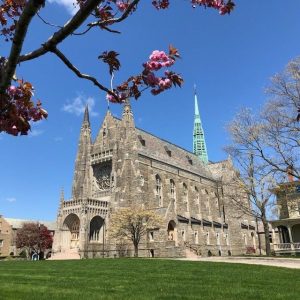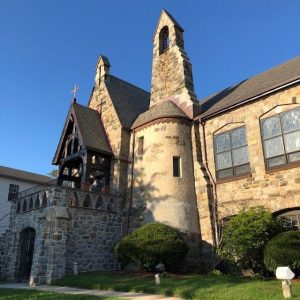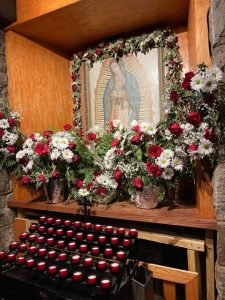 |
 |
|
| The Original Parish of St. Mary, in Stamford, Connecticut
The undertaking of a new endeavor is always a challenge. And so, it was for the new “parish-to-be”. Saint Mary of the Assumption, in Stamford, Connecticut. In the month of August 1907, the parishioners of St. John the Evangelist Church were surprised at the news from the Bishop of Hartford, the Most Reverend Michael Tierney, DD., that Stamford was to have a new parish. The same day he designed the eastern area of the city as the home for the new parish as he placed it under the protection of the Mother of God. The same day that the bishop erected the new parish he also appointed the new pastor, Reverend Dennis L. Gleason, D.D., who has ministered until then the parishioners of Saint Anthony Church in Hartford. The new parishioners attended their last mass at St. John on August 25th. The following Sunday they were to meet their new pastor at the first Eucharistic Celebration held at the Casino on Suburban Avenue. There was kindness in his greeting and sympathy in his words as he spoke to them of the challenges ahead after their separation from their mother parish. The hall of the Casino served as the chapel for the eleven months where the parishioners gathered around their new pastor in support of his effort to give them a new church. In the meantime, for special celebrations, the pastor of Saint John lead the new community of faithful the temple for special celebrations. Continue reading. |
|
The Original Parish of Saint Benedict, in Stamford, Connecticut
The Parish of Saint Benedict, although smaller than Saint Mary’s has a rich history as well. It all begun with the Slovak migration to the City of Stamford, mostly after the second half of the 19th century. Slovak Catholics sought to escape persecution in their own land and, as skilled laborers they found employment in Southern Connecticut. Gradually, Slovak families moved mostly into the Cove area of the City of Stamford, close to factories and places of employment. They kept a closely knit community, strengthened by several Slovak-American organizations active both at the national and local level. By the end of the 19th century the Stamford Catholic Slovak community had managed to secure a social hall on Seaside Avenue where they not only celebrate social events but religious ones as well. It was at the turn of the century when Slovak Catholics secured the support of the Bishop of Hartford and were recognized as a community in need of spiritual assistance. Thanks to many sacrificial efforts Catholic Slovaks funded the building of Saint Benedict’s church, dedicated in 1931 which served as the center for their “national church” located within the territory of Saint Mary parish. |
| The Spanish-Speaking Catholic Community of Stamford
The Spanish-speaking Catholic community of Stamford became officially active under the patronage of Our Lady of Montserrat from 1964 on and has a more recent history marked by a constant struggle and steady growth. Spanish-speaking Catholics gradually became an important presence in the city mainly thanks to the Puerto Rican migration of the late 1940’s. Cubans, Colombians, Peruvians and other Spanish-speaking Catholic groups were added to the mix during the 50’s and 60’s. Initially, they worshipped in the basement of Saint John’s church, on Atlantic Street. A church building was secured on Grove Street in 1964, and a parish was assigned to them on that site until 1986. This community was later ordered by the Local Ordinary to worship for a short time at Saint Clements church; after only two years, they secured the purchase of a small church on Hope Street, aided by the kindness of some members of the Protestant community. In 1995, Saint Mary’s Parish begun to offer the Mass in Spanish thus helping alleviate the issue of lack of space experienced by the faithful that worshipped at Hope Street. The Spanish-speaking Catholic community’s fast growth pace led the Local Ordinary to, once more, move it to a new place of worship, this time the parish of Saint Benedict and, in the year 2000, the parish communities of Saint Benedict and Our Lady of Montserrat were merged into one; the church of Saint Benedict became their official place of worship while Masses in Spanish continued to be celebrated at the church of Saint Mary. Bishop Frank Caggiano created the new Parish of Saint Mary of Stamford on May 1, 2020, by officially bringing together three of the most active communities of faithful Catholics in Stamford. Today, Saint Mary of Stamford Parish is home to people from all over the globe with a sizable number of Central Americans, especially from Guatemala. Every country in the Americas is represented here. There are also a good number Catholics from Europe, Asia and Africa -we now even have people from New York! |

|
Continuation of the Original Parish of St. Mary, in Stamford, Connecticut History
On October 14, 1907, the two parish trustees, Mr. Edward Duffy & Cornelius O’Leary met with Father Gleason at Mr. Duffy’s office on Pacific Street to perfect the legal incorporation of the parish. The official corporate title of the new parish was “The Saint Mary’s Roman Catholic Church of Stamford”. The new parish community was to include all Catholics not cared for by particular national parishes established by the diocesan authority in a greater portion of East Stamford.
At that meeting the pastor was authorized to purchase from Mr. John G. Wigg the house at 168 (now 418) Elm Street to serve as the new rectory. Daily Mass was celebrated at the rectory in a makeshift chapel in one of the rooms.
During the winter months of 1907-1908, Father Gleason was anxiously seeking a suitable site for a parish church. Thomas McMahon, one of his own parishioners, owned a lot 50 x 150 feet on Elm Street near the rectory. He generously offered his property for the church. At a special meeting of the church corporation on April 28, 1908, the pastor was authorized to “purchase property, borrow money and build a church”. It was on this site that the church was built from plans prepared by Chickering and O’Connell, an architectural firm from Boston. The contract was awarded to Max Durrschmidt of Derby. After the work had commenced in June, the parishioners saw their new parish in eight weeks.
The Most Reverend Bishop Michael Tierney, D.D. a former pastor of St. John the Evangelist came to Stamford for the blessing of the church on Sunday, August 2, 1908; only eleven months after he had established the parish. The ceremony was celebrated with a Solemn High Mass at which the Reverend Peter F. McClean was the speaker. Later in the evening the parishioners gathered to celebrate Vespers at which Reverend Andrew J. Plunkett delivered the sermon. Bishop Tierney died two months later, on October 5, 1908.
Parish activities at the new church got underway and within one year the debt from the construction of the parish were paid for. During the next twenty-year over one hundred twenty children received their First Holy Communion and six hundred ninety-five Confirmations. Concerned with the spiritual welfare of the parish, Father Gleason established the Holy Name Society. The small parish began to flourish and grow.
It was soon felt that the small parish needed more room for expansion. In the spring of 1915, Dr. CS Wardwell offered to St. Mary parish the opportunity to acquire the Isaac Wardwell property at the corner of Elm Street and Shippan Avenue for the construction of a bigger church. The property was transferred in April of 1915. The continued support of the faithful had given the parish $35,000 much needed funds for the expansion.
The new land served as the home for the new church as well as building lots that some of the parish members had purchased for their homes. The church and rectory (the original Wardwell Homestead) occupies three and a half acres. The present rectory was moved from its original site to accommodate the new church building.
By 1924 there were six Masses celebrate on a given Sunday. O’Connell and Shaw of Boston were commissioned in 1925 to draw plans for the new church. The plans were submitted to contractors for bids. When estimates were received, it was found that the cost for the new buildings would far surpass expectations. A parish meeting was called to discuss the matter. An unanimously approved motion by those who present instructed the pastor to “build the church as designed, and we will pay for it”.
The Holy Name Society raised $ 15,000 to pay for the main altar. The “Ladies of St. Mary” raised over $13,000 to purchase the organ. They are two bronze plaques in the church, which are evidence to the many special gifts of generous individuals.
Max Durrschmidt from Derby, the same constructor who had built the previous church, commenced operations for the new church on July 10, 1925, and the cornerstone bears that date even though it was not laid on the Sunday afternoon of June 13, 1926. Most Reverend Mauric F. McAuliffe, D.D., auxiliary bishop of the diocese, came to Stamford for the purpose. During the service Reverend John H. Anderson, D.D., pastor of St. Anne Church in Devon gave the sermon.
The original trowel used by the bishop for the occasion was awarded to Mr. John B. Quinn, memorable trustee of the parish who dedicated many years to God in the service of his parish.
The Most Reverend John J. Nihal, D.D., bishop carried out the dedication of the new church on June 17, 1928, by the Most Reverend John J. Nihal, D.D. bishop of the diocese. Twenty-one years after the first Mass in the Casino on Elm Street the parishioners had their definitive temple for worship. At the same time Reverend Joseph E. Joyce D, D. was celebration Mass in the new Church, the last Mass was being celebrated in the old church. Thus, the parish community celebrated the passing of the old to the new. The new church was completed at the sum of $519,000. At the end of 1928 the remaining debt was only $100,000. Helping enormously to pay for the church were the generous donations of all the parishioner’s donations made by them through the newly introduced envelope system.
In May of 1938 a parcel of land adjacent to St. Mary Church was purchased to find the parish school. On February 9, 1939, four Sisters of St. Joseph moved into the new convent, which had been created, from the remodeling of an old home, which originally stood on the property. The construction of the parish school was not to take place immediately due to the high cost of inflation during the following years.
In 1945 Father Gleason, pastor for 38 years, received the joyous news that he has to be honored by Pope Pius XII receiving the dignity of Domestic Prelate pastorate bearing the title of Right Reverend Monsignor. The ceremony of investiture took place on January 20, 1946, with Rt. Rev, Msgr. William H Flynn, Vicar General of the diocese, presiding.
By 1950 all things were in place to commence the constructions of the school. The school was designed by Francis L.S. Mayers of Stamford and built by the firm of George L Hickey, Inc. Stamford. In August 1951 twelve sisters of the Presentation from Fitchburg, Massachusetts began arriving for the opening of the school on September 5. The dedication of the school took place on September 9.
During the 1950’s St Mary Church had a flourishing community. A total of 9 Masses were celebrated on Sunday; six upstairs in the main church and three downstairs in the chapel dedicated by Bishop Shehan on November 20, 1955, after Msgr. Gleason’s death.
Just as things were flourishing, the health of Msgr. Gleason was ailing. The “humble monsignor” and untiring shepherd was a weakened man by the time he celebrated his 88th birthday on January 22, 1953. He offered his last Mass on that day. In February he entered St. Joseph Hospital and died on the 17th at 10:20pm in the presence of a nurse and Rev. James A. Lord, an assistant at the parish. In February there was a Requiem Mass celebrated, and his body was buried at the priest’s circle at St. John Cemetery. To honor Msgr. Gleason the parishioners erected a bronze memorial in the front of the church, which was dedicated in July 1954 by Bishop Lawrence J. Shehan.
Thus, the first chapter was closed in the history of St. Mary Parish. Over the many years to follow, new chapters have come and gone. The pastors who have given their lives in service of Saint Mary Parish over the past one hundred years have dedicated their fruitful years to the buildings up of a strong faith community. Nine men have been called by God to lead the community in the living their faith to the fullest.
